Jim
Forum Replies Created
-
JimParticipantA couple of years ago I purchased a copy of "All the Birds of the World" - a rather large, heavy book. I was really stunned by the number of birds that looked alike though they were in many different parts of the world. Most of them were related - in the same genus. But it didn't really strike me until a birding trip to Belize last month - my first trip south of Florida - and I was the Golden Fronted Woodpecker and the Yucatan Woodpecker. They both looked strikingly similar to the Red-bellied Woodpeckers in my back yard with the Yucatan being the smaller version of the other two. In Belize I assumed it was some form of mimicry, like Hairy and Downy, but I looked them up and, unlike Hairy and Downy, all three of these are in the same genus. They're just look-alike cousins.in reply to: What Makes a Woodpecker a Woodpecker #1020498
-
JimParticipantSo I tried once more and tried to be patient and draw the feathers.
 in reply to: Draw: Northern Cardinal Feathers #946127
in reply to: Draw: Northern Cardinal Feathers #946127 -
JimParticipantI think my problem is that I am impatient when it comes to drawing feathers. I think I tend to rush to "finish the drawing". I'll keep working on this however. Seeing what others have done has given my a better idea of what I need to work on.
 in reply to: Draw: Northern Cardinal Feathers #945241
in reply to: Draw: Northern Cardinal Feathers #945241 -
JimParticipantI've always attracted a lot of birds to my yard because I have a lot of feeders and bird baths. But I've made some changes that have attracted non-feeder birds too. A couple of years ago I got the HOA lawn maintenance folks to agree to stop putting weed killer and insecticides on my grass. The upside is that I have Northern Flickers that now regularly forage for ants in my back yard grass. The downside has been that I have to get out there and dig weeds like dandelions, clover and crab grass (all of which I learned are not native plants - clover being the worst according to the Indiana DNR) and it's not a lush green lawn like the neighbors'. Last fall, I left the leaf litter in the back yard planting area; I also got the leaves off the grass before the HOA did and chopped them up for compost/mulch in my planting beds. And this spring, I did not disturb the leaf litter until the temperature was regularly in the 50s. This year I got a number of ground foragers other than Robins - like Brown Thrasher, Swainson's Thrush, Veery, Fox Sparrow, Song Sparrow, Eastern Towhee- that I didn't attract before. I'm fortunate to have big native trees out back that came with the house - oak, hickory, sassafras, beech - that host the various insects I have yet to learn about. And a dozen years ago we put in three hemlocks which we did not know at that time are a great shelter for birds in winter.in reply to: Enjoy and Share #822077
-
JimParticipantI obviously don't know where you live, but a good source for those of us in the Midwest is Prairie Nursery, an on-line supplier based in Wisconsin. I've gotten two orders now for plants native to northern Indiana - Ninebark, a variety of Asters and some others - and the plants are excellent. The sixteen I put in last fall have all come up this spring and are thriving. They also have some garden layout ideas - I used a layout for partial shade. I did not just Google search for this outfit - I joined the Indiana Native Plant Society group on Facebook and learned about them there. I have a small patch but this outfit also supplies folks who are "going native" and converting acres of land into native preserves.
-
JimParticipantOne good thing about Garlic Mustard is that it pulls up easily. I learned about it last year when I started volunteering to do "maintenance" at our local Audubon Bird Sanctuary. One day I filled two dozen large garbage bags with them. Some were nearly five feet tall. But the folks who taught me explained that GM is a bi-annual so any seeds that sprout this year don't flower and generate new seeds until next year. So in my own yard last year, I concentrated on pulling all those in flower. This spring I did the same - and pulled them from the neighbor's yard too. I expect going forward I'll have many fewer to pull - only seeds that blow in from someplace else. From the Audubon Society folks I also learned about and got rid of the Amur Honeysuckle, Oriental Bittersweet, Creeping Charlie, White Clover, and a few others. With the room to grow and get sun, this year I found three Jack-in-the-Pulpit plants and the open space that used to hold all the GM is now filled with native Virginia Creeper. I'm feeling pretty good about what I've been doing so far.in reply to: Gather Your Local Knowledge #822051
-
JimParticipantI live in northern Indiana and learned about things like amur honeysuckle and burning bush only a few years ago. I had two burning bushes that were only about six feet tall and I got rid of them three years ago. I dug around them and used a hatchet to chop out the roots a section at a time. Then I just kept digging and prying. It took a few hours for each one. I've since put in Ninebarks which are doing great. One got its first flowers this spring. I put in an elderberry bush - Black Lace - before I knew the difference between native and non-native plants. I don't have any other elderberry (two others, not black lace, didn't make it through the first winter) and don't think there are any in the area so I do not expect it to fruit. What I do want to find out is whether I need to pull it up or not. From what I have seen in google searches thus far, it's not considered invasive at the moment. But also what I've seen tells me that if I get a native elderberry, it might pollinate the Black Lace.in reply to: Give Birds What They Need #821631
-
JimParticipantThis year I've learned that I have quite a bit beyond my bird feeders. I have trees with nuts - oaks, hemlocks, and beech and trees with fruit - sassafras and serviceberry. I have good shelter with three large hemlocks. I never paid much attention to them before this spring when I started doing a weekly survey using Nature's Notebook. I started working in native plants last year and also began leaving the leaf litter on the ground. This year I've seen lots of ground foragers in the leaves and under bushes - like sparrows and thrushes. I had a small wood pile this winter for the first time and noticed a Carolina Wren around it almost daily. I'm retired now and obviously will have to pass this house on to someone else down the road. I want to make sure I have plenty of native plantings around the yard so that even if the next owner is not into birds/wildlife the yard will still be a suitable habitat for them.in reply to: Give Birds What They Need #819272
-
JimParticipant
 Certainly no LCF but I feel pretty good about my progress in the course. Three months ago I had never held a watercolor brush in my hand so anything is progress! But I am feeling better about some of the color blends I am getting and I plan to keep sketching and painting. Thanks Liz! in reply to: See How Far You’ve Come #684570
Certainly no LCF but I feel pretty good about my progress in the course. Three months ago I had never held a watercolor brush in my hand so anything is progress! But I am feeling better about some of the color blends I am getting and I plan to keep sketching and painting. Thanks Liz! in reply to: See How Far You’ve Come #684570 -
JimParticipantI was able to get every item at Michael's - both in Naples, FL and here in South Bend, IN. Have fun!in reply to: See How Far You’ve Come #684302
-
JimParticipant
@Lee Ann van Leer I got everything at Michael's - both in Naples, FL and here in South Bend, IN.
in reply to: See How Far You’ve Come #684296 -
JimParticipant

 -
So I did the first one (on the left) back in December. The one on the right I did just now. There is certainly some progress. I am going to try the watercolor next, but I do struggle with that a lot. We shall see! in reply to: See How Far You’ve Come #684295
-
So I did the first one (on the left) back in December. The one on the right I did just now. There is certainly some progress. I am going to try the watercolor next, but I do struggle with that a lot. We shall see! in reply to: See How Far You’ve Come #684295 -
JimParticipantIt's still too chilly here in Northern Indiana to go sit out back and sketch, so I've been working on copying some of my birding photos. I'm pretty encouraged given I hadn't drawn anything since about the 5th grade - close to 60 years ago. The hardest thing for me is mixing colors. I suspect it will be even more difficult once I head outside.

 in reply to: Filling Your Sketches with Color #676986
in reply to: Filling Your Sketches with Color #676986 -
JimParticipant
 Yes it is an interesting exercise. I have not gone outside yet to try it. But I did sense that I was spending more time looking at details on the subject rather than just trying to get the general impression on paper. It will also be interesting to see how this ties in to "sketching" which seems to lend itself to capturing general impressions rather than structural details. in reply to: Focusing on Your Subject – Blind Contour Drawing #658916
Yes it is an interesting exercise. I have not gone outside yet to try it. But I did sense that I was spending more time looking at details on the subject rather than just trying to get the general impression on paper. It will also be interesting to see how this ties in to "sketching" which seems to lend itself to capturing general impressions rather than structural details. in reply to: Focusing on Your Subject – Blind Contour Drawing #658916 -
JimParticipant

 I am in Florida for a couple of months. The back of our condo is quite small and there are few birds that come by though they are regular. There are a couple dozen different species around the neighborhood retention ponds and I get to see them every day. I do have a sit spot at home in Indiana where I have a couple of dozen bird feeders year round and thus lots of birds every day. The tree in the first picture is directly out back here - on the other side of the retaining wall. When the local Gnat-catchers and Palm Warblers come by, this is where they forage for insects. They don't stay long though and they certainly don't stay still. But I enjoy listening to them and to all the others that I can hear but not see. in reply to: Opening Your Senses #658444
I am in Florida for a couple of months. The back of our condo is quite small and there are few birds that come by though they are regular. There are a couple dozen different species around the neighborhood retention ponds and I get to see them every day. I do have a sit spot at home in Indiana where I have a couple of dozen bird feeders year round and thus lots of birds every day. The tree in the first picture is directly out back here - on the other side of the retaining wall. When the local Gnat-catchers and Palm Warblers come by, this is where they forage for insects. They don't stay long though and they certainly don't stay still. But I enjoy listening to them and to all the others that I can hear but not see. in reply to: Opening Your Senses #658444 -
JimParticipant
 OK I think it's time for me to start practicing what I have learned thus far before I move on to the next lessons. This is my first time taking lessons in drawing anything so I don't need to rush it. in reply to: Illustrating the 3D World #654052
OK I think it's time for me to start practicing what I have learned thus far before I move on to the next lessons. This is my first time taking lessons in drawing anything so I don't need to rush it. in reply to: Illustrating the 3D World #654052 -
JimParticipant
 1. Having the photo gave me time to look at what I was doing and then look at the photo. I am not sure what this would have looked like had I only had a couple of seconds to see the bird and then had to draw purely from memory. I am surprised at how much it actually looks like a bird!
2. I saw others' drawings - those who added labels saying what the colors are. I will start doing that as I think it will help me in the field to develop a habit of looking for more details in the overall appearance of the birds. in reply to: Jump Right in! #653579
1. Having the photo gave me time to look at what I was doing and then look at the photo. I am not sure what this would have looked like had I only had a couple of seconds to see the bird and then had to draw purely from memory. I am surprised at how much it actually looks like a bird!
2. I saw others' drawings - those who added labels saying what the colors are. I will start doing that as I think it will help me in the field to develop a habit of looking for more details in the overall appearance of the birds. in reply to: Jump Right in! #653579 -
JimParticipant1. Initially, I signed up for this course because it's the only Cornell course left for me to take! But I used to write in a journal when I started going on retreat to a monastery in Kentucky thirty years ago. I only did it there and it was usually after spending hours outside sitting alone in the woods or by some small lake. I learned a lot about myself from those entries and I want to get back to that. I'm retired now and spend as much time as I can "out there with the birds" and need to start writing down some of the great thoughts I have. 2. I like the idea of using boxes to highlight thoughts and questions and even sketches. I can't draw - my stick figures are even pathetic but a couple of the journalers did not look like they were Norman Rockwell's descendants so perhaps there is some hope for me as well! 3. I had an eye-opening moment this past summer on a vacation trip to Moscow (Viking River Cruise) where I noticed some behavior by local birds called Fieldfares that really made me think about people - humans in general. I'm going to try to gain insights from the birds I see and how they live by including bigger questions in my journal - questions that likely don't have answers just more questions.in reply to: Style Your Journal Your Way #653577
-
JimParticipantThe fact that Prof Townsend observed a 25% inbreeding rate is rather troubling. I suspect that the crow populations observed have a higher instance of disease and other genetic weaknesses as a result. It may leave them more vulnerable to the impact of climate change. On the other hand, if 75% are not related and have a higher survival rate than other species, perhaps the overall survival rate of the population is still greater than one sees in other species that do not have that level of inbreeding. I would be interested in seeing more followup studies on crow populations which seems possible given the extensive banding that you all have done over the last couple of decades.in reply to: Secret Sex Lives #636926

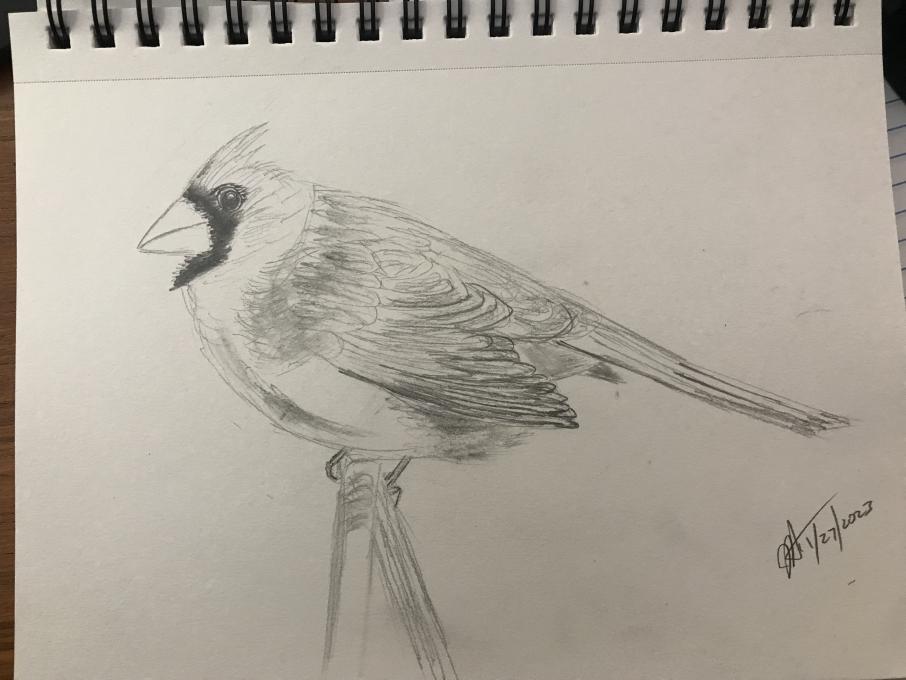
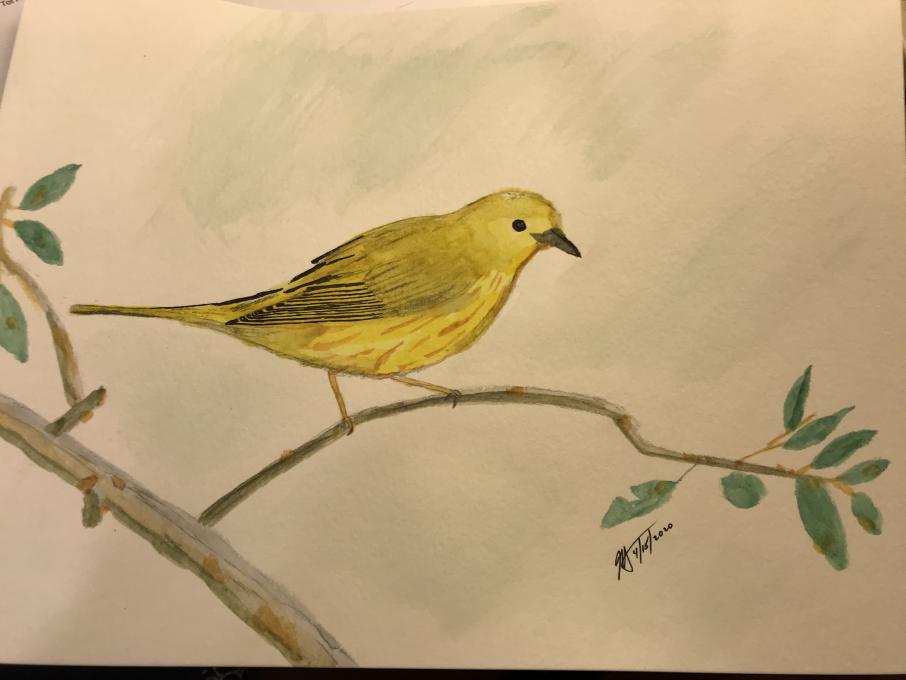 Certainly no LCF but I feel pretty good about my progress in the course. Three months ago I had never held a watercolor brush in my hand so anything is progress! But I am feeling better about some of the color blends I am getting and I plan to keep sketching and painting. Thanks Liz!
Certainly no LCF but I feel pretty good about my progress in the course. Three months ago I had never held a watercolor brush in my hand so anything is progress! But I am feeling better about some of the color blends I am getting and I plan to keep sketching and painting. Thanks Liz! 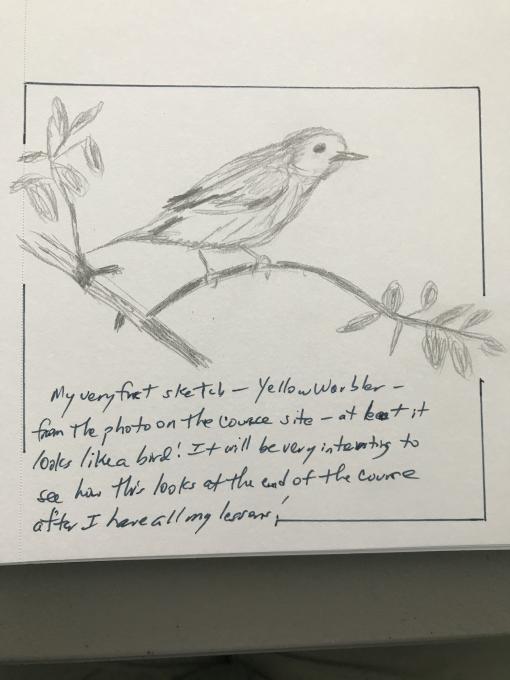
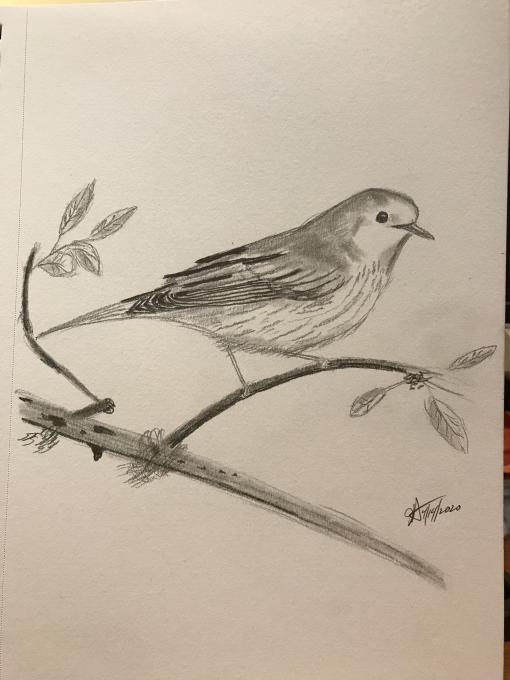 -
So I did the first one (on the left) back in December. The one on the right I did just now. There is certainly some progress. I am going to try the watercolor next, but I do struggle with that a lot. We shall see!
-
So I did the first one (on the left) back in December. The one on the right I did just now. There is certainly some progress. I am going to try the watercolor next, but I do struggle with that a lot. We shall see! 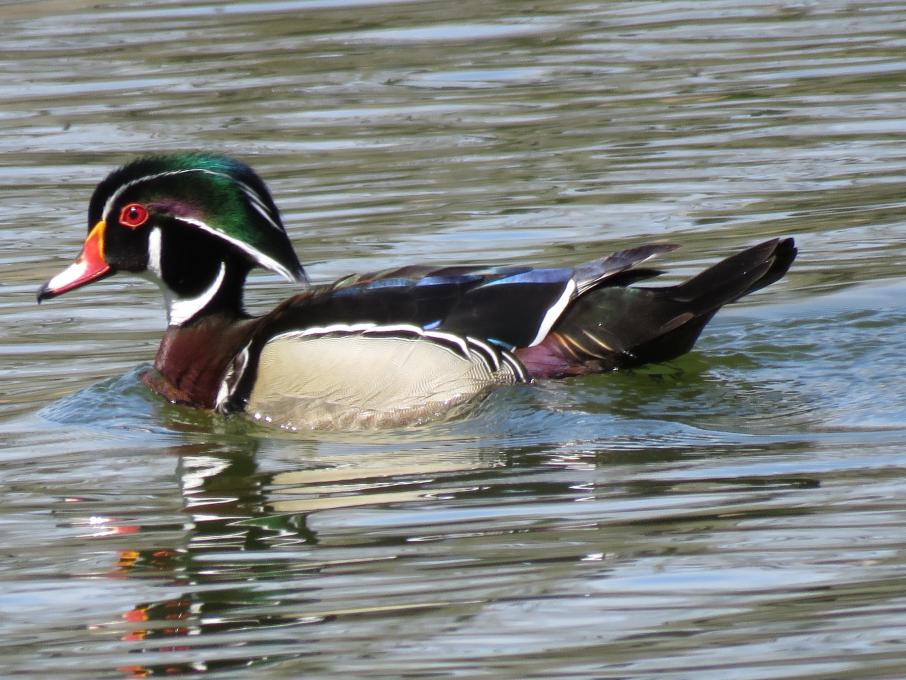

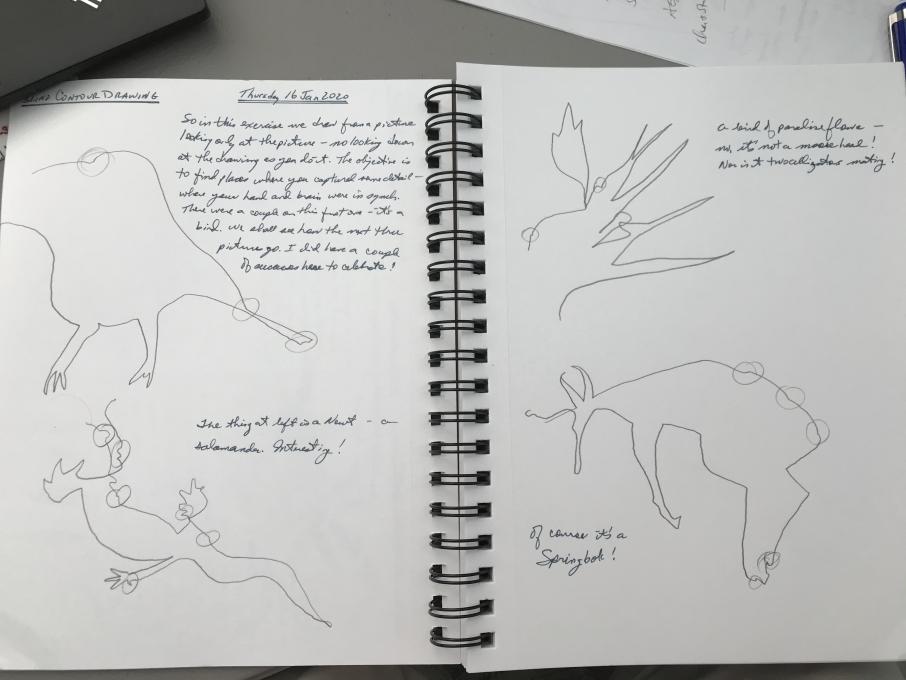 Yes it is an interesting exercise. I have not gone outside yet to try it. But I did sense that I was spending more time looking at details on the subject rather than just trying to get the general impression on paper. It will also be interesting to see how this ties in to "sketching" which seems to lend itself to capturing general impressions rather than structural details.
Yes it is an interesting exercise. I have not gone outside yet to try it. But I did sense that I was spending more time looking at details on the subject rather than just trying to get the general impression on paper. It will also be interesting to see how this ties in to "sketching" which seems to lend itself to capturing general impressions rather than structural details. 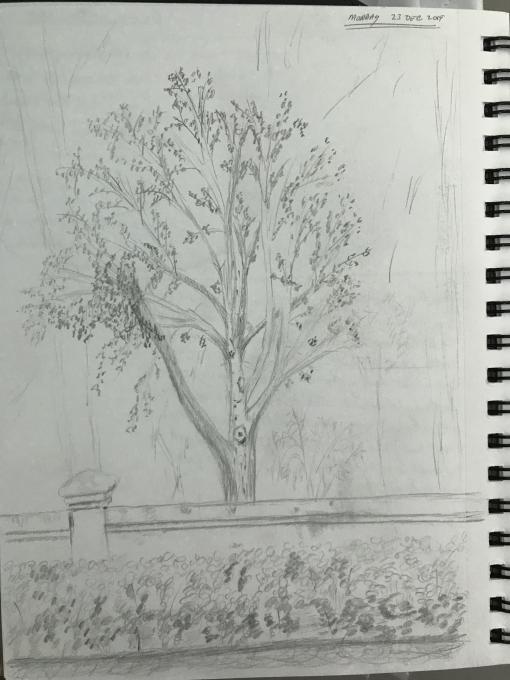
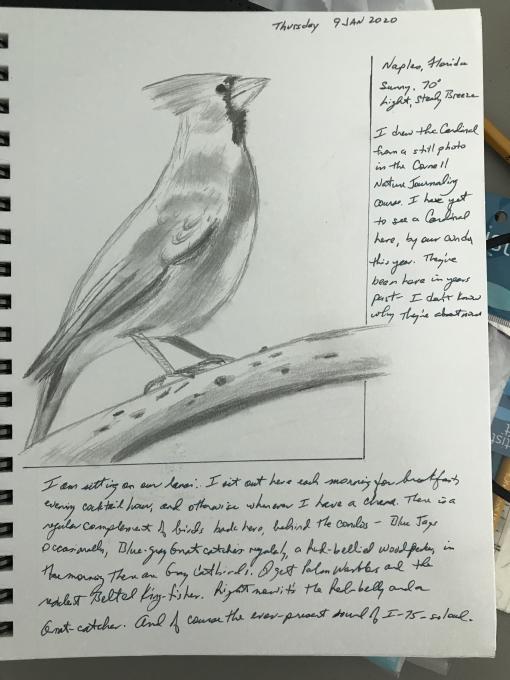 I am in Florida for a couple of months. The back of our condo is quite small and there are few birds that come by though they are regular. There are a couple dozen different species around the neighborhood retention ponds and I get to see them every day. I do have a sit spot at home in Indiana where I have a couple of dozen bird feeders year round and thus lots of birds every day. The tree in the first picture is directly out back here - on the other side of the retaining wall. When the local Gnat-catchers and Palm Warblers come by, this is where they forage for insects. They don't stay long though and they certainly don't stay still. But I enjoy listening to them and to all the others that I can hear but not see.
I am in Florida for a couple of months. The back of our condo is quite small and there are few birds that come by though they are regular. There are a couple dozen different species around the neighborhood retention ponds and I get to see them every day. I do have a sit spot at home in Indiana where I have a couple of dozen bird feeders year round and thus lots of birds every day. The tree in the first picture is directly out back here - on the other side of the retaining wall. When the local Gnat-catchers and Palm Warblers come by, this is where they forage for insects. They don't stay long though and they certainly don't stay still. But I enjoy listening to them and to all the others that I can hear but not see. 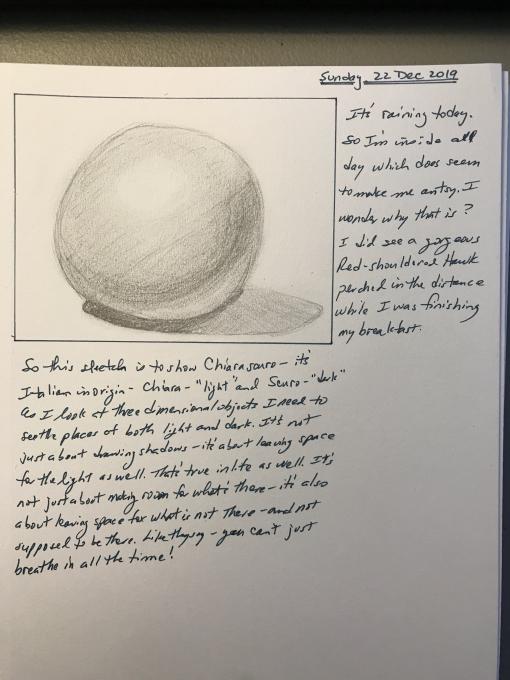 OK I think it's time for me to start practicing what I have learned thus far before I move on to the next lessons. This is my first time taking lessons in drawing anything so I don't need to rush it.
OK I think it's time for me to start practicing what I have learned thus far before I move on to the next lessons. This is my first time taking lessons in drawing anything so I don't need to rush it. 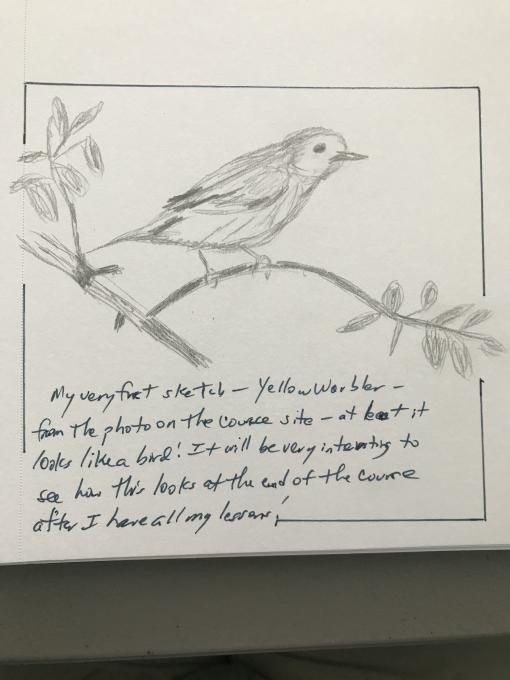 1. Having the photo gave me time to look at what I was doing and then look at the photo. I am not sure what this would have looked like had I only had a couple of seconds to see the bird and then had to draw purely from memory. I am surprised at how much it actually looks like a bird!
2. I saw others' drawings - those who added labels saying what the colors are. I will start doing that as I think it will help me in the field to develop a habit of looking for more details in the overall appearance of the birds.
1. Having the photo gave me time to look at what I was doing and then look at the photo. I am not sure what this would have looked like had I only had a couple of seconds to see the bird and then had to draw purely from memory. I am surprised at how much it actually looks like a bird!
2. I saw others' drawings - those who added labels saying what the colors are. I will start doing that as I think it will help me in the field to develop a habit of looking for more details in the overall appearance of the birds.